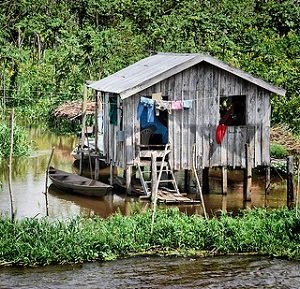Clean Rainwater and Clean River Water May be Available in Some Areas Along with Other Forms of Surface Water
Clean rainwater and clean river water may be available in some areas along with other forms of surface water.
Note: The content on this page has been adapted from technical notes published by USAID, entitled “Water for the World”.
Water that does not infiltrate the ground is called surface water. Surface water appears either as direct runoff flowing over impermeable or saturated surfaces which then collects in large reservoirs and streams or as water flowing to the ground from surface openings.
Surface water and is the most conspicuous water source there is; found in every lake, steam, and river around us.
As clean rainwater flows across surfaces, it picks up contaminants which may be harmful to humans and carries them into surface water sources.
In order to use it for drinking, a surface water source must be well protected and the water that is collected must be treated to remove dangerous pathogens.

There are places on earth where water is abundant, but clean drinking water is still scarce.
People living in equatorial rain forests and other rainy environments often have an abundance of clean rainwater, but suffer from "water, water everywhere, but not a drop to drink".
In these areas, clean rainwater and surface water can be collected, treated, and used for drinking.
For purposes of this website we will discuss five classes of surface water sources:
(1) Springs and Seeps
(2) Lakes and Ponds
(3) Rivers and Streams
(5) Sand Dams
(4) Rainfall Catchments
Follow the links below to find a description of methods typically used to develop each source and their advantages and disadvantages.
Clean rainwater and surface water sources can be developed for drinking water but special care must be taken to ensure the quality of the water.
Springs and seeps generally offer the best alternative in terms of cost, water quality and maintenance. Spring water also is cool and fresh-tasting and very acceptable to the users.
Lakes and ponds offer good, accessible quantities of water. Water from ponds and lakes is easily delivered to users by installing intakes.
Ponds, lakes, and especially small community ponds, are often exposed to contamination. Generally, water from them should not be used unless adequate water treatment is available.
Rivers and streams also provide good sources or water if developed properly. Stream and river water that is naturally filtered into wells offers a good, low- cost method for using surface water.
Untreated stream water from higher elevations is also available at low cost to the user. Near estuaries and at low elevations, contamination is likely and the water must be treated before it is used.
Sand dams built across seasonal rivers and streams are one more water catchment strategy being successfully implemented in places like Kenya and Brazil.
Harvesting rainwater with roof catchments offers the advantage that they can be constructed in the yard of the user if the house has a suitable roof.
Each individual is responsible for his own system. Water quality is variable with rain catchments and will depend on the user’s willingness to clean the roof often and disinfect the cistern occasionally.
Ground catchments provide a fairly good quantity of water. With storage, a ground catchment system can meet the needs of a community. Ground catchments are expensive to install and use large areas of land which is scarce in many regions.
The choice of a method depends on many factors including the source and resources available and community preferences.
Refer to the Summary of Methods of Developing Sources of Surface Waterfor a quick reference of the development methods discussed in these pages.
Return "Home" from "Clean Rainwater"









